Related Research Articles

Roland Corporation is a Japanese multinational manufacturer of electronic musical instruments, electronic equipment, and software. It was founded by Ikutaro Kakehashi in Osaka on 18 April 1972. In 2005, its headquarters relocated to Hamamatsu in Shizuoka Prefecture. It has factories in Malaysia, Taiwan, Japan, and the United States. As of December 2022, it employed 2,783 people. In 2014, it was subject to a management buyout by its CEO, Junichi Miki, supported by Taiyo Pacific Partners.

Digital music technology encompasses the use of digital instruments to produce, perform or record music. These instruments vary, including computers, electronic effects units, software, and digital audio equipment. Digital music technology is used in performance, playback, recording, composition, mixing, analysis and editing of music, by professions in all parts of the music industry.

A groovebox is a self-contained electronic or digital musical instrument for the production of live, loop-based electronic music with a high degree of user control facilitating improvisation. The term "Groovebox" was originally used by Roland Corporation to refer to its MC-303, released in 1996. The term has since entered general use, and the concept dates back to the Movement Computer Systems Drum Computer in 1981 and Fairlight CMI Page R in 1982.
A music workstation is an electronic musical instrument providing the facilities of:

A sampler is an electronic musical instrument that records and plays back samples. Samples may comprise elements such as rhythm, melody, speech, sound effects or longer portions of music.

The Roland MC-303 is the first of a series of musical instruments known as a groovebox. It combines a simple sound module with a sequencer to record and store notation, along with controls aimed at encouraging the musician to improvise the music while it is playing. Despite the number in its name and the attention it received at its launch, the MC-303 has more in common with other MC prefixed synthesizers, which contain built-in sequencers, than it does with the famous Roland TB-303. As the first Groovebox, the MC-303 was the first in a line of inexpensive products specifically targeted towards house DJs and amateur home musicians rather than professional producers. It was superseded by the Roland MC-505. It is the predecessor to the Roland JX-305, Roland D2, Roland MC-307, Roland EG-101, Roland MC-09, Roland MC-909, Roland MC-808, and most recently the Roland MC-707 in 2019, along with its more portable sibling, the Roland MC-101.

Hip hop production is the creation of hip hop music in a recording studio. While the term encompasses all aspects of hip hop music creation, including recording the rapping of an MC, a turntablist or DJ providing a beat, playing samples and "scratching" using record players and the creation of a rhythmic backing track, using a drum machine or sequencer, it is most commonly used to refer to recording the instrumental, non-lyrical and non-vocal aspects of hip hop.

The discontinued Roland MC-909 Sampling Groovebox combines the features of a synthesizer, sequencer, and sampler, with extensive hands-on control of both the sound engine and the sequencing flow. It was intended primarily for live performance of pre-programmed patterns consisting of up to 16 tracks of MIDI data. It was released by Roland Corporation on October 8, 2002. This product was announced at the AES Fall Convention in 2002. It is the direct successor to the Roland MC-505 and is the predecessor to the Roland MC-808. Which eventually ended the "Groovebox by year 2010" line of products by Roland which began in the year 1996 with the Original Roland MC-303 groovebox. The Roland Groovebox began again resurgence in the year 2019 with a two new modern & redesign Roland MC-707 GROOVEBOX/Roland MC-101 GROOVEBOX. The Roland MC-909 was developed from the blueprint of Roland's own "Roland Fantom-S Workstation & Roland Fantom-X Workstation" and uses the same structure and operating system, with some differences regarding the Patterns section, not implemented in the Roland Fantom S/X6/X7/X8 Workstation.

The Boss Dr. Sample SP-303 is a discontinued digital sampler from Boss, successor of the Boss SP-202 Dr. Sample. The SP-303 was revamped and redesigned in 2005, and released as the SP-404, by Roland Corporation.
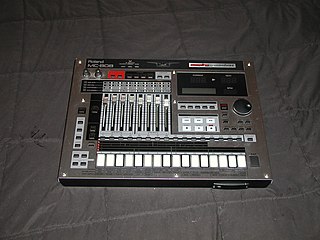
The MC-808 is a groovebox introduced by Roland in 2006. It is the successor to the late Roland MC-303, Roland MC-307, Roland MC-505 and Roland MC-909.
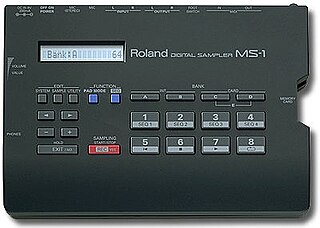
The Roland MS-1 digital sampler was a compact, 16-bit digital audio phrase sampler produced by Roland in 1994 as a straightforward, inexpensive, entry-level sampler. In 1998, the MS-1 was succeeded by the Boss SP-202 sampler.

The Roland SP-404 Sampling Workstation is a discontinued sampler made by Roland Corporation. Released in 2005, it is part of the SP family and successor to where Boss Corporation’s SP-505 sampler left off. The sampler was succeeded by the SP-555 in 2008, but was later given its own upgrade as the Roland SP-404SX Linear Wave Sampler in 2009. Another upgrade, the Roland SP-404A Linear Wave Sampler was released in 2017. A third upgrade, the SP-404MKII was released in 2021. The Roland SP-404 has played a huge role in influencing the sound of popular Hip Hop subgenre known as Lofi HipHop.
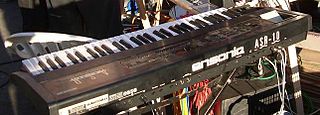
The Ensoniq ASR-10 is a sampling keyboard produced by Ensoniq between 1992 and 1998. The ASR-10 was a follow-up product to the very popular Ensoniq EPS and EPS-16 Plus performance samplers, and was also available with a piano style weighted keyboard (ASR-88) and a rackmount version (ASR-10R). At the time, the machine was one of the most powerful samplers available.
The Roland SP-555 is a discontinued music sampler manufactured by Roland Corporation. The 555 is part of the SP family, which includes Boss’s popular SP-303 and Roland's SP-404 installments. The sampler was released in 2008.
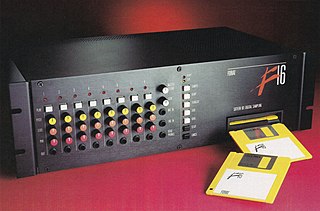
The Forat F16 is the first 16 bit digital sampler optimized for use as an electronic drum module. It dynamically responds to trigger inputs from MIDI and/or audio signals. With a response time of 0.1 milliseconds, the F16 is the fastest audio triggering digital sampler ever sold. It was manufactured by Forat Music and Electronics, introduced in 1987 at a list price of $5200 and was discontinued in 1994. An optional Remote Control and SCSI capability was available for $1385.
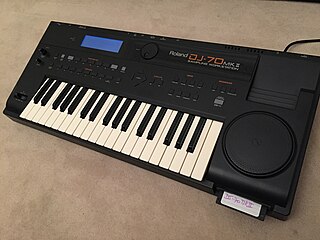
The Roland DJ-70 is a 16-bit linear A/D Conversion & 20-bit linear D/A Conversion sampling workstation and was released in 1992 by Roland Italy.
The BOSS SP-505 Groove Sampling Workstation/SP-505 is a sampling workstation made by Boss Corporation, which is a division of Roland Corporation. The digital sampler is part of the SP family and was released in the year of 2002, as a follow-up to Roland’s SP-303 installment. Ironically, both the 303 and 505 installments were succeeded by the release of Roland's SP-404 in the year of 2005.
The Boss Dr. Sample SP-202 is a discontinued sampling workstation made by Boss Corporation, a division under Roland Corporation. Released in the year of 1998, it is the premier installment to the SP family, which includes Boss's popular SP-303 and Roland's SP-404 installments. The sampler is also successor to Roland's MS-1 Digital Sampler.

The Roland SP-606 is a music sampler manufactured by Roland Corporation. It is part of the SP family, which includes Roland’s popular SP-303 and SP-404 installments. Released in the year of 2004, the sampler was soon succeeded in 2005 by the SP-404.
References
- ↑ Corporation, Roland. "Roland - SP-808 | Groove Sampler". Roland.
- ↑ Corporation, Roland. "Roland - SP-808EX | e-MIX Studio". Roland.
- ↑ Wolbe, Trent (October 17, 2013). "The Classics: Roland SP-808 Groove Sampler". The Verge.
- ↑ "Encyclotronic: Synthesizers > Roland > Roland SP-808". www.Encyclotronic.com.
- ↑ "Vintage Synth Explorer:SP-808". www.vintagesynth.com.
- ↑ "Cris Carter". www.soundonsound.com.
- ↑ "Elfpack:Craig Jones". Elfpack.com.
- ↑ "Hear and Now". New York Magazine. 22 October 2001.